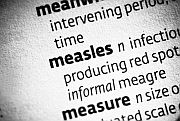
FRIDAY, April 17, 2015 (HealthDay News) — The California measles outbreak that began last December at two Disney parks was officially declared over Friday by state health officials.
A total of 131 people in California were diagnosed with measles during the outbreak, according to the state’s Department of Public Health.
However, additional cases were reported outside of California, and the U.S. Centers for Disease Control and Prevention said Thursday that the latest total in the outbreak was 159 cases.
“We are pleased this outbreak is over, but caution that measles can be reintroduced in California at any time when an infected person brings it to the state,” Dr. Karen Smith, director of the California Department of Public Health, said in a news release. “The best defense for protection against the highly infectious measles is vaccination.”
The outbreak reignited a debate over the anti-vaccine movement, because a significant number of people infected had not been vaccinated against the highly contagious disease or had only received one dose of the vaccine that protects against measles. Two doses are recommended.
According to the CDC, more than 80 percent of all the cases in the outbreak occurred among people who were unvaccinated or had an unknown vaccination status. The Disney outbreak accounted for 70 percent of all measles cases nationwide this year, the agency added.
California health officials said that of the patients for whom they had documentation, 57 of the 131 cases were unvaccinated, while another 25 had one or more doses of the measles vaccine.
Health officials have explained that vaccination rates must be very high to protect an entire population against an infectious disease like measles, but they said the anti-vaccine movement had lowered those rates.
Although measles was declared eliminated from the United States in 2000, “approximately 20 million measles cases occur [worldwide] annually, and importations to the U.S. will continue to place unvaccinated populations at risk for measles,” CDC researchers reported in the April 17 issue of the Morbidity and Mortality Weekly Report, an agency publication.
Therefore, “measles transmission in pockets of unvaccinated persons increases the risk for transmission to vulnerable groups, such as those who cannot be vaccinated because of underlying medical conditions, or infants too young to be vaccinated,” the researchers said.
“The continued risk for importation of measles into the United States and occurrence of measles cases and outbreaks in communities with high proportions of unvaccinated persons highlight the need for sustained, high vaccination coverage across the country,” corresponding author Nakia Clemmons, and colleagues at the CDC, concluded.
Measles symptoms can include fever, cough and watery eyes followed by a telltale rash.
A measles outbreak is considered over when 42 days — or two incubation periods — have passed since the last onset of the rash, according to the California Department of Public Health.
More information
Visit the U.S. Centers for Disease Control and Prevention for more about measles.
Copyright © 2025 HealthDay. All rights reserved.

